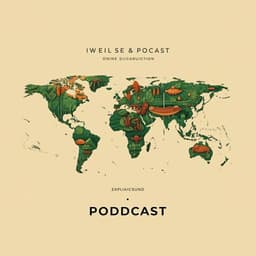
Agriculture
Constraints to urban agriculture in southeast Nigeria
C. C. Olumba, C. N. Olumba, et al.
This study conducted by Chukwudi Charles Olumba, Cynthia Nneka Olumba, and Jonathan Okechukwu Alimba delves into the challenges urban farmers face in southeast Nigeria, uncovering critical infrastructural, socio-economic/environmental, and institutional constraints. The findings highlight the urgent need for policy responses and infrastructural support to unlock urban agriculture's full potential.
~3 min • Beginner • English
Introduction
Rapid urbanization, especially in the global south, is increasing pressure on urban food systems. Urban agriculture (UA)—the cultivation of crops and rearing of livestock within or on the fringe of metropolitan areas—has been proposed as a strategy to enhance urban food security, livelihoods, and environmental outcomes. While UA is practiced globally, motivations and modalities differ between the global north (often recreational/social, fruit/vegetable focus) and south (food security/poverty alleviation, use of vacant spaces, ponds, rented or marginal land). Despite its benefits, UA faces constraints such as loss of agricultural land due to urban expansion and land-use change, tenure insecurity, limited access to credit and insurance, inadequate extension support, input shortages, and socio-environmental challenges. In Nigeria’s rapidly urbanising southeast, UA is increasingly recognized and contributes to household food security. This study addresses the research need to identify key factors deterring UA activities. Objectives: (i) ascertain the types of agro-enterprises urban farmers engage in; (ii) examine the constraints faced by urban farmers.
Literature Review
Prior research highlights both benefits and constraints of UA. Benefits include improved household food availability and dietary diversity, livelihood and employment opportunities, and environmental gains through reduced food miles and urban greening. Constraints commonly reported in the global south include: urbanization-induced displacement of prime agricultural land and competing land uses; weak land market regulations disadvantaging agriculture; tenure insecurity hindering investment; limited access to credit and insurance due to distrust or low awareness; inadequate extension services and information; shortages of inputs, equipment, water and labor; market access and infrastructure gaps; and environmental stresses including climate variability and disease outbreaks. Studies across Nigeria and other countries (e.g., Burkina Faso, Uganda, Ethiopia, India) consistently report input scarcity, poor extension, high costs (housing/feed), inadequate insemination or improved breeds in livestock, labor shortages, post-harvest and marketing constraints. These findings motivate a localized assessment of constraints in southeast Nigeria.
Methodology
Study area: Urban areas in Nigeria’s southeast (Enugu, Imo, Anambra, Abia, Ebonyi), a humid tropical region with dense population and significant urban settlements (e.g., Enugu, Aba, Owerri, Abakaliki). The study focuses on formally recognized UA within state capital territories. Sample and sampling: The study population comprised contact (registered) urban farmers. A multi-stage sampling design was used. First, three states (Ebonyi, Enugu, Imo) were purposively selected due to availability of updated farmer lists at Agricultural Development Programme (ADP) and Fadama III offices. Second, three urban settlements per state were randomly selected (Ebonyi: Abakaliki, Afikpo North, Ezza South; Enugu: Enugu North, Enugu South, Enugu East; Imo: Owerri Municipal, Orlu, Okigwe). The sampling frame included 931 registered urban farmers (Ebonyi 202, Enugu 192, Imo 537). Third, 280 farmers were proportionately and randomly selected (61 Ebonyi, 58 Enugu, 161 Imo). Data collection: Primary data were collected April–September 2018 via face-to-face interviews using a semi-structured, paper-based questionnaire. Instruments were pre-tested; six trained assistants conducted the survey. Farmers indicated engagement (Yes/No; multiple allowed) across a comprehensive list of urban agro-enterprises. Constraints were elicited from literature and farmer inputs; an additional item on cattle invasion was included given local tensions. Respondents rated the extent of each constraint on a 4-point Likert scale (1 very low; 2 low; 3 great; 4 very great; with 0 do not know). Clarifying descriptions were provided for each constraint. Data analysis: Descriptive statistics (frequencies, percentages) characterized enterprise engagement. Factor analysis using principal component analysis (PCA) identified latent constraint dimensions. Exploratory factor analysis (IBM SPSS v22) used varimax rotation; the Kaiser rule retained loadings ≥0.40. Suitability checks: KMO measure of sampling adequacy = 0.523 (satisfactory); Bartlett’s test of sphericity χ² = 2564.533, df = 210, p < 0.001; Cronbach’s alpha = 0.754 (acceptable internal consistency). Three components with eigenvalues >1 were retained; 21 of 24 variables loaded ≥0.40. Confirmatory assessment (STATA v15) evaluated reliability and discriminant validity: composite reliabilities >0.70 (SE 0.795, IF 0.792, IN 0.771); Cronbach’s alpha for SE 0.735, IF 0.721, IN 0.66 (interpreted as acceptable given composite reliability). Discriminant validity was supported as Average Variance Extracted (SE 0.360; IF 0.300; IN 0.408) exceeded squared inter-factor correlations (SE–IF 0.203; SE–IN 0.027; IF–IN 0.015).
Key Findings
Agro-enterprises: Four main types were identified, with many farmers engaging in multiple enterprises. Crop production: maize (75%), cassava (~70%), vegetables (~67%), rice (8%). Livestock: poultry (60%), fish (25%), pigs (22%), goats (19%), snails (14%), sheep (7%). Agro-processing: cassava products (66%), cereals (42%), palm produce (26%), fish (24%), livestock products (23%), legumes and nuts (16%), yam (4%). Input supply: cassava stems (60%), fertilizers (50%), seedlings (45%), farm implements (38%), livestock feed (24%), breeding stock (23%), agro-chemicals (18%), farm equipment (10%). PCA of constraints: Three principal components (total variance explained 61.35%). Factor 1: Socio-economic/environmental constraints—low household income (0.688), inadequate information (0.672), climate change/variability (0.661), reduced labor availability (0.592), rapid population growth (0.554), unaffordability of land (0.520), high food prices (0.477). Factor 2: Infrastructural constraints—capital-intensive technologies (0.621), cattle invasion (0.599), lack of labor-saving devices (0.594), poor feeder roads (0.582), use of crude implements (0.575), inadequate/lack of access to improved inputs (0.532), lack of basic amenities (electricity, clean water) (0.521), poor post-harvest processing and storage technologies (0.447), poor market infrastructure (0.424). Factor 3: Institutional constraints—poor governance (0.759), low priority for urban farming (0.732), poor credit facilities (0.586), land grabbing (0.550), weak extension service delivery (0.528). Validity and reliability checks supported the measurement structure (KMO 0.523; Bartlett’s p<0.001; Cronbach’s alpha overall 0.754; composite reliability ≥0.771; AVE tests passed discriminant validity).
Discussion
Findings show widespread enterprise diversification among urban farmers, which can stabilize income and manage risk. Crop choices skew toward short-duration staples (maize, cassava, vegetables), likely reflecting tenure insecurity and small or marginal plots in urban settings, reducing incentives for long-gestation crops. Livestock activities are common but biased toward smaller stock (poultry), consistent with land scarcity, cultural demand, and urban space constraints. The constraint structure clarifies binding bottlenecks: (1) socio-economic/environmental risks—income limitations, climate variability, labor scarcity, land unaffordability and rapid population growth undermine production capacity; (2) infrastructural deficits—poor roads, market facilities, post-harvest and storage technologies, limited access to improved inputs and labor-saving devices directly depress productivity and market access; (3) institutional weaknesses—poor governance, low policy priority for UA, credit constraints, land grabbing, and weak extension services reduce farmers’ capacity to invest, adopt improved practices, and secure land. Addressing these constraints aligns with improving food security and livelihoods in rapidly urbanizing areas, supporting the study’s objectives to identify enterprise patterns and key barriers to UA.
Conclusion
The study documents active and diversified UA in southeast Nigeria across crop production, livestock, agro-processing, and input supply, with maize and poultry most prevalent. PCA reveals three principal constraint domains—socio-economic/environmental, infrastructural, and institutional—that jointly explain the majority of variation in reported challenges. Policy recommendations include: improving infrastructure (feeder roads, market facilities, post-harvest processing and storage), expanding and tailoring extension services to urban contexts (including sustainable intensification to cope with land shortages), integrating UA into urban land-use planning and earmarking public green spaces for UA, protecting against land grabbing, and providing timely input subsidies and incentives alongside improved credit access. These measures can enhance the viability of UA and strengthen urban food security. The study contributes updated empirical evidence on UA enterprises and constraints in a rapidly urbanizing Nigerian region and informs municipal planning and policy.
Limitations
The study focuses on cities in southeast Nigeria; generalizability to other regions may be limited. The sample size (n=280) is relatively small and aggregated across diverse agro-ecological zones. The sampling frame included only registered urban farmers (ADP and Fadama III), potentially excluding unregistered practitioners. Future research should replicate in other regions and countries, examine differences by gender and agro-enterprise type, include perspectives of government agencies and consumers, and analyze spatial-temporal dynamics of UA and farmland conversion using remote sensing.
Related Publications
Explore these studies to deepen your understanding of the subject.







